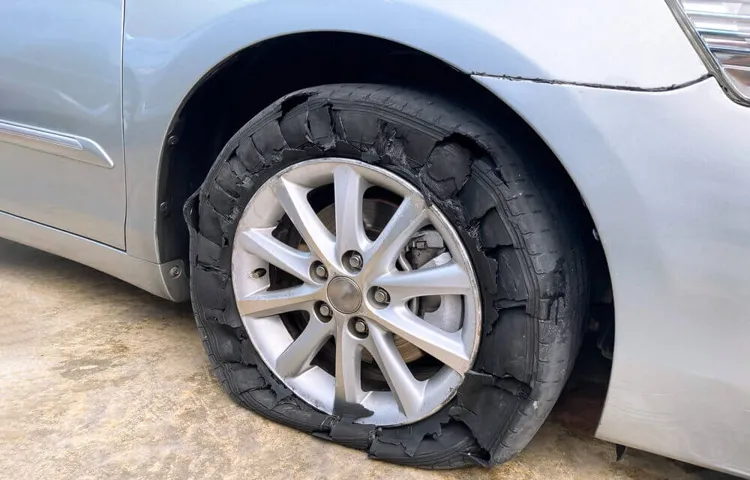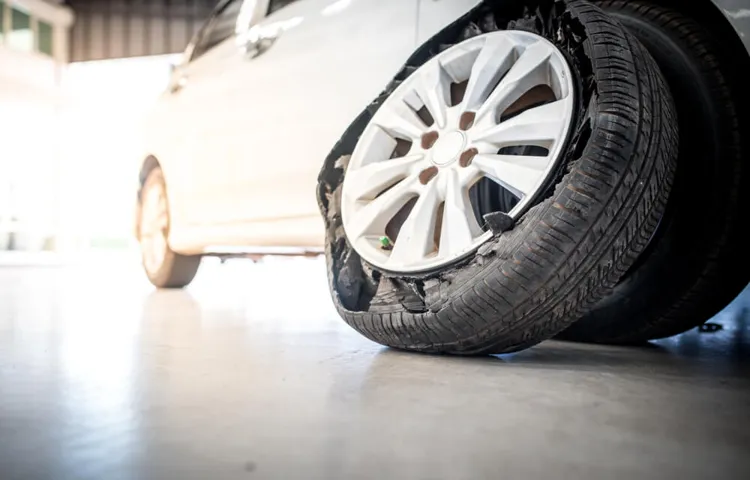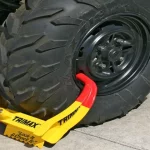Have you ever wondered what happens to your old tires once they are thrown away? Instead of taking up space in landfills, they often end up in a shredder. But how do tires get shredded? Tire shredding is the process of breaking down old, used tires into smaller pieces that can be recycled or disposed of safely. The first step in shredding tires involves removing any metal debris such as wires or rims, which can cause damage to the shredding machine.
Once the tires are cleared of any metal, they are shredded into smaller pieces by a powerful machine. These pieces can range in size from small chips to large chunks depending on the end use. The shredded tire pieces are then sorted by size, and any materials that can be recycled, such as rubber and steel, are separated from non-recyclable waste.
The shredding process is crucial for ensuring that old tires don’t end up in landfills or pollute the environment. By shredding tires, we can reuse and recycle their materials for new products, from playground surfaces to car parts. So, the next time you’re wondering what happens to your old tires, know that they may be shredded and recycled into something new.
Table of Contents
What is Tire Shredding?
Tire shredding is a process that involves using specialized machinery to grind up used tires into small pieces. The shredded rubber can then be repurposed for various applications, such as playground surfaces, rubberized asphalt, and even new tires. But how does a tire get shredded? First, the tires are typically sorted by size and type, as different shredders are used for different kinds of tires.
Then, the tires are fed into the shredder, which uses cutting blades or rotating discs to tear the rubber into small pieces. In some cases, the shredded rubber may also be further processed through a granulator to create even smaller particles. Overall, tire shredding is an efficient and sustainable way to recycle used tires and reduce waste in our landfills.
Definition of Tire Shredding
Tire shredding is the process of chopping up used tires into smaller pieces. This process not only reduces the amount of space that used tires occupy in landfills, but it also turns them into useful materials. These shredded tires can be used for many applications like playgrounds, landscaping, and even road construction.
One of the most important benefits of tire shredding is that it eliminates the need for incineration, which releases harmful emissions into the environment. Instead, tire shredding helps to promote a circular economy by reducing waste, reusing primary resources, and contributing to a more sustainable future. Overall, tire shredding is an essential part of modern waste management practices that benefit both the environment and society as a whole.

Different Types of Tire Shredding Machines
Tire shredding is the process of breaking down worn-out tires into smaller, more manageable pieces. These pieces can then be used for a variety of purposes, from making new tires to creating playground surfaces and fuel for industrial processes. There are several different types of tire shredding machines available, each of which is designed to handle different types of tires and operate at different levels of capacity.
Some popular options include single-shaft shredders, two-shaft shredders, and specialty tire shredders that are designed specifically for large or heavy-duty tires. Regardless of the type of machine chosen, the key to successful tire shredding is to choose a system that is sturdy, reliable, and capable of handling the specific needs of your business.
Causes of Tire Shredding
Tire shredding can occur due to a range of causes, including excessive wear and tear, overloading, and poor road conditions. When tires become overly worn, the rubber becomes brittle and more prone to tearing apart. Overloading, or carrying more weight than the tire is designed for, can cause the tire to overheat and fail.
Poor road conditions, such as potholes, sharp debris and uneven pavement, can also contribute to tire shredding. Additionally, improper tire maintenance can lead to issues such as low tire pressure or alignment problems, which can increase the likelihood of shredding. By taking proper care of your tires and avoiding overloading or rough driving conditions, you can help prevent the risk of tire shredding and keep your vehicle running safely and smoothly.
Factors that Affect Tire Wear and Tear
Tire shredding can be caused by a variety of factors, including poor maintenance, rough road conditions, and age. One of the most common causes of tire shredding is improper inflation. Overinflated or underinflated tires can cause uneven wear, which can result in shredding.
Additionally, driving on rough roads can cause damage to the tires, leading to shredding. This can be especially problematic for tires that are already worn or overused. Age is also a factor in tire wear and tear, as older tires are more susceptible to failure.
Regular inspection and maintenance, including proper inflation and rotation, can help prevent tire shredding and increase the lifespan of your tires.
External Forces that Damage Tires
Tire Shredding When it comes to tire shredding, external forces are often the culprit. One of the main causes is road hazards. Potholes, nails, and other debris can puncture and damage tires, leading to shredding.
Overloading the vehicle beyond the recommended weight limit can also cause tire shredding. When the vehicle is too heavy, it puts excessive pressure on the tires, leading to wear and tear. Extreme temperatures can also play a role in tire shredding.
Prolonged exposure to high temperatures can cause the tire’s rubber to break down and weaken. Finally, poor tire maintenance can also contribute to tire shredding. Failing to maintain proper air pressure levels and neglecting to check for signs of wear and tear can cause the tire to fail prematurely.
To avoid tire shredding, drivers should be aware of road hazards, avoid overloading their vehicle, and maintain proper tire maintenance.
Signs of Tire Shredding
Tire shredding can be a serious issue, and it’s important to keep an eye out for signs of wear and tear on your tires. One of the main causes of tire shredding is overinflation, which puts excess pressure on the tire and causes it to wear unevenly. You might notice that your tire tread is starting to look thin in one area or that there are cracks starting to appear in the sidewall.
Tires can also shred due to underinflation, which can cause the tire to flex too much and eventually lead to failure. In addition to checking your tire pressure regularly, it’s also important to make sure that your tires are properly aligned and balanced. If you notice any signs of shredding or wear on your tires, it’s important to get them checked out by a professional as soon as possible to avoid any safety issues on the road.
Visual Indicators to Identify Shredded Tires
When it comes to identifying shredded tires, there are several visual indicators that you can look out for. The most obvious sign is the presence of small bits of rubber scattered around the tire. These bits can range in size from tiny grains to larger chunks, and they may appear darker or lighter than the surrounding pavement.
Another clue is the presence of skid marks or patterns on the road. These marks can be a result of the tire shredding, which can cause the vehicle to lose grip and slide. Additionally, if you notice that the tire looks misshapen, has bulges, or has a gash in the sidewall, it could be a sign of damage that could lead to shredding in the future.
Remember to inspect your tires regularly for any signs of wear and tear, and don’t hesitate to replace them if necessary. By being vigilant, you can prevent dangerous situations on the road and ensure your safety while driving.
Symptoms of Driving with a Shredded Tire
If you’re driving with a shredded tire, there are a few telltale signs that you’ll want to look out for. The first sign is the noise – you’ll likely hear a loud thumping or flapping sound as the tire makes contact with the road. This is because the shredded tire is no longer balanced and is bouncing around, which can be dangerous for you and other drivers on the road.
Another sign is the vibration – you may feel the car shake or vibrate as you’re driving. This is because the shredded tire is no longer able to provide a smooth ride, and the other tires are having to compensate for its lack of stability. Finally, you may notice that your car is pulling to one side or the other.
This is because the damaged tire is no longer able to provide the necessary traction to keep the car moving straight. If you spot any of these signs while driving, it’s crucial that you pull over immediately and have the tire checked out by a professional. Driving with a shredded tire can be extremely dangerous and can lead to accidents, so it’s always better to err on the side of caution.
Preventing Tire Shredding
“Preventing Tire Shredding – How to Keep Your Tires Safe” Tire shredding is a common problem that many drivers face, especially those who frequently drive on rough roads or highways. So, how does a tire get shredded in the first place? There are a number of reasons why tires can shred, including overuse, old age, poor maintenance, and improper inflation. Overloading your vehicle can also cause this problem.
When a tire is not inflated properly, it can flatten and become more prone to wear and tear. Weather conditions such as rain, snow, and extreme heat can also contribute to the problem. To prevent tire shredding, it’s important to maintain your tires properly by checking the pressure regularly and replacing them when needed.
Avoid overloading your vehicle, and if you frequently drive on rough roads, consider investing in tires with a higher ply rating. By taking these precautions, you can keep yourself, your passengers, and other drivers safe while on the road.
Regular Tire Maintenance and Inspection Tips
Preventing Tire Shredding through Regular Maintenance and Inspection Maintaining your tires regularly can prevent them from shredding and causing accidents on the road. Inspection and maintenance of your tires should be conducted once a month or before long-distance trips. The first step is to ensure that your tire pressure is at the recommended level, which can be found on the car manufacturer’s manual or inside the driver’s door.
Underinflated tires cause more friction on the road and can result in the tire shredding or bursting. Additionally, inspect your tires for wear and tear on the tread and sidewall. If you notice any abnormal bulges or cracks, have a mechanic inspect your tires immediately.
The right tread depth for your tires guarantees maximum traction and grip on the road. To avoid tire shredding, ensure that your tires are always maintained and inspected regularly. Remember, your tires are the only point of contact between your car and the road, so keeping them in top shape is crucial for your safety and that of other drivers on the road.
Using Quality Tires to Avoid Shredding
As a driver, experiencing a tire blowout can be one of the worst nightmares come true. Tire shredding occurs when the tire becomes severely worn-out resulting in a sudden tear. Punctured tires can also lead to shredding if left unattended.
Preventing tire shredding should be a priority for every driver. One way to avoid this trouble is by opting for quality tires. Choosing good quality tires not only enhances vehicle performance but also helps in avoiding tire shredding incidents.
Quality tires are built to withstand impact and are designed to offer excellent traction. Investing in quality tires may seem like an expensive option, but it is a cost-effective approach in the long haul. So, the next time you go out to purchase tires, make sure you invest in ones that will last longer, work better, and help you avoid the risk of experiencing a tire shredding disaster.
Remember, safety first!
Conclusion
In the grand scheme of things, tires are a crucial component for any vehicle – they are the unsung heroes that keep us on the road and moving. Yet, at times, they can be finicky and prone to shredding, leaving us stranded and cursing their existence. But fear not, as science has shown us that a combination of wear and tear, incorrect inflation, road hazards, and even the occasional nail can be the culprits behind a shredded tire.
So the next time you find yourself staring at a frayed piece of rubber, remember that life is unpredictable and even the toughest of components can sometimes fail – but don’t let a shredded tire deflate your sense of adventure!”
FAQs
What causes tire shredding?
Tire shredding can be caused by several factors such as overloading, underinflation, overinflation, worn-out tires, and road hazards.
How can I prevent my tire from shredding?
Regular maintenance of your tires such as checking the air pressure, rotating the tires, and inspecting for any signs of wear and tear, can help prevent tire shredding.
What are the signs of a shredded tire?
The signs of a shredded tire include vibrations, loud noises, decrease in control of the vehicle, and visible damage to the tire.
Can a shredded tire be repaired?
It is not recommended to repair a shredded tire as it can be dangerous and compromise the safety of the vehicle.
How long does a tire last before it starts shredding?
The lifespan of a tire depends on various factors such as the quality of the tire, the driving conditions, and the maintenance of the tire. However, on average, a tire can last up to 6 years before shredding.
Is tire shredding covered under warranty?
Tire shredding caused by manufacturing defects is usually covered under the manufacturer’s warranty. However, tire shredding caused by factors such as wear and tear, road hazards, and improper maintenance is not covered under warranty.
What should I do if my tire starts shredding while driving?
If your tire starts shredding while driving, it is important to remain calm, slow down and pull over to a safe location. Call for roadside assistance or a tow truck to replace the tire.



